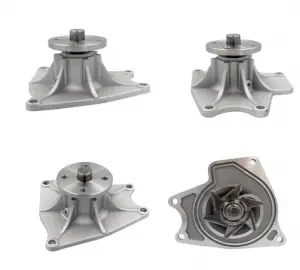The engine cooling water pump is the heart of the automobile engine cooling system. Its function is to increase the working pressure of the coolant in the circulation system, maintain the coolant circulation between related engine components, and prevent the engine operating temperature from being too high. Depending on the supporting requirements and working conditions, the structural types of engine cooling water pumps include centrifugal pumps, vortex pumps, and rotary positive displacement pumps. Due to space size limitations, a single-stage centrifugal pump consisting of a water inlet chamber, an impeller, and a water outlet chamber is usually used. This structure has the characteristics of small size, light weight, large water supply, and simple structure. It is the most widely used structural type. A typical centrifugal cooling circulating water pump mainly consists of a pump body, an impeller, a bearing, a water seal and a pulley.
There are many parts around the engine cooling water pump, and its structural design must comply with the overall layout requirements of the engine, so that the flow path of the water pump in and out, the shape and section of the volute chamber, the layout of the water pump inlet and outlet, the impeller inlet structure and the basic size are determined etc. are often difficult to meet normal hydraulic design requirements, thus directly affecting the improvement of operating performance including efficiency. The structure of the water inlet chamber of the engine cooling water pump is divided into straight cylinder type or spiral shape, and the structure of the water outlet chamber is spiral shape and is integrated with the engine casting. The structural geometric parameters of the impeller have a decisive influence on the operating performance of the water pump. Engine cooling water pumps generally adopt a semi-open impeller structure without a front cover.
Post time: Jan-16-2024

